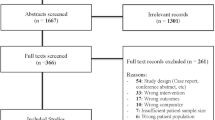Abstract
Background
To date, it has been difficult to compare medical therapy for gastroesophageal reflux disease with that of surgical management from a scientific viewpoint, mainly because of the lack of standardization of the operative technique. This study was designed to identify a methodology for standardization of surgical technique and to measure the effectiveness of this standardization.
Methods
Surgeons contributing to a major international multicenter trial comparing optimum medical therapy with surgical therapy for treatment of gastroesophageal reflux attempted to optimize their surgical techniques so that a realistic comparison could be made that may aid clinical decision-making. The surgeons met, shared their techniques using video, and produced a standardized set of criteria for the surgical centers and a common operative technique. Data collection methods ensured accuracy of the records of the procedure applied and the data were analyzed for consistency with set surgical standards.
Results
There was a high degree of conformity (>95%) between the recommended method of performing a Nissen fundoplication as defined in the trial protocol, and variations were restricted to isolated individuals. The operations were completed without mortality, few conversions, and with very low postoperative morbidity.
Conclusions
This study has shown that, contrary to commonly held belief, surgeons are able to standardize their work for the purposes of measuring the outcome of an operative procedure within the context of a randomized, controlled trial.
Similar content being viewed by others
References
Urbach DR, Baxter NN (2005) Reducing variation in surgical care. BMJ 330:1401–2
Nissen R (1956) Eine einfache Operation zur Beeinflussung fer Refluxoesophagitis. Schweiz Med Wochenschr 86:590–2
Nissen R (1961) Gastropexy and fundoplication in the management of complex reflux problems. Am J Dig Dis 6:954–7
Rosetti M, Hell K (1977) Fundoplication in the treatment of gastroesophageal reflux in hiatal hernia. World J Surg 1:439–444
Donahue PE, Samelson S, Nyhus LM, et al. (1985) The floppy Nissen fundoplication. Arch Surg 120:663–8
DeMeester TR, Bonnavina L, Albertucci M (1986) Nissen fundoplication for gastroesophageal reflux disease. An evaluation of primary repair in 100 consecutive patients. Ann Surg 204:9–20
Devereaux PJ, Bhandari M, Clarke M, et al. (2005) Need for expertise based randomised controlled trials. BMJ 330:88
Horton R (1996) Surgical research or comic opera: questions but few answers. Lancet 347:984–5
Rantanen TK, Salo JA, Sipponen JT (1999) Fatal and life-threatening complications in antireflux surgery: analysis of 5502 operations. Br J Surg 86:1573–1577
Viljakka M., Luostarinen M., Isolauri J (1997) Complications of open and laparoscopic anti-reflux surgery. 32-years audit at a teaching hospital. J Am Coll Surg 185:446–450
Watson DI, Jamieson GG, Devitt PG, et al. (1995) Para-esophageal hiatus hernia: an important complication of laparoscopic Nissen fundoplication. Br J Surg 82:521–523
Peridikis G, Hinder RA, Lund RJ, et al. (1997) Laparoscopic Nissen fundoplication: where do we stand? Surg Laparosc Endosc 7:17–21
Booth MI, Jones L, Stratford J, et al. (2002) Results of laparoscopic Nissen fundoplication at 2–8 years after surgery. Br J Surg 89:476–481
Loustarinen MES, Isolauri JO (1999) Surgical experience improves the long-term results of Nissen fundoplication. Scand J Gastroenterol 34:117–120
Acknowledgments
The LOTUS study was funded by AstraZeneca. The authors thank all AstraZeneca personnel involved in the excellent planning and coordination of the study and acknowledge the high level of expertise and commitment provided by all of the principal investigators and participating centers, and also acknowledge Dr. Madeline Frame of AstraZeneca for medical writing assistance with the manuscript preparation.
Author information
Authors and Affiliations
Consortia
Corresponding author
Rights and permissions
About this article
Cite this article
Attwood, S.E.A., Lundell, L., Ell, C. et al. Standardization of Surgical Technique in Antireflux Surgery: The LOTUS Trial Experience. World J Surg 32, 995–998 (2008). https://doi.org/10.1007/s00268-007-9409-4
Published:
Issue Date:
DOI: https://doi.org/10.1007/s00268-007-9409-4




